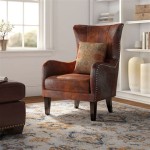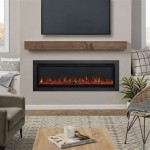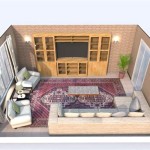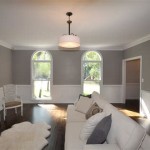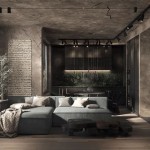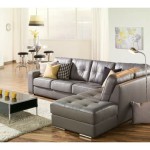Elevating Your Living Room with Thoughtful TV Integration
The living room, often the heart of a home, serves as a central gathering place for relaxation, entertainment, and social interaction. Determining the optimal placement and integration of a television within this space is a critical design decision. It requires careful consideration of factors like room size, viewing distance, ambient lighting, and overall aesthetic preferences. A poorly planned TV setup can disrupt the flow of the room, detract from its visual appeal, and even negatively impact the viewing experience. Conversely, a well-integrated television can seamlessly blend with the existing décor, enhance the functionality of the living room, and create an inviting and comfortable environment for both casual viewing and immersive entertainment.
This article explores various strategies and considerations for integrating a television into a living room. It provides insights into optimizing viewing angles, concealing unsightly cables, selecting appropriate furniture, and incorporating the television into a cohesive design scheme. The goal is to provide readers with the knowledge and inspiration needed to create a living room that is both visually appealing and functionally suitable for their entertainment needs.
Optimizing Viewing Angle and Distance
The first step in planning a living room TV setup is to determine the optimal viewing angle and distance. A comfortable viewing angle minimizes strain on the neck and eyes, while the appropriate viewing distance ensures that the image is clear, sharp, and immersive without causing distortion or pixelation. The ideal viewing angle is typically considered to be between 15 and 30 degrees from the center of the screen. This allows viewers to comfortably see the entire image without excessive head movement.
The optimal viewing distance is directly related to the size and resolution of the television screen. A general rule of thumb is to multiply the screen size (measured diagonally) by 1.5 to 2.5 to determine the ideal viewing distance. For example, for a 55-inch television, the viewing distance should be between 82.5 inches (6.9 feet) and 137.5 inches (11.5 feet). It's important to note that these are just guidelines, and personal preferences may vary. Some individuals may prefer to sit closer to the screen for a more immersive experience, while others may prefer a greater distance for a more relaxed viewing experience.
The height of the television is also a crucial consideration. The center of the screen should be at or slightly below eye level for comfortable viewing. This typically means that the television should be mounted or placed on a stand so that the center of the screen is approximately 40 to 48 inches from the floor. However, this may need to be adjusted based on the height of the seating and the individual preferences of the viewers. If the television is mounted too high, it can cause neck strain and discomfort over extended viewing periods.
When arranging furniture, ensure that seating is positioned to face the television directly. Avoid placing seating at extreme angles to the screen, as this can distort the image and cause eye strain. Consider the placement of windows and other light sources to minimize glare on the screen. If glare is unavoidable, consider using curtains or blinds to control the amount of light entering the room.
Concealing Cables and Wires
One of the most common challenges in integrating a television into a living room is dealing with the unsightly mess of cables and wires. These cables can detract from the visual appeal of the room and create a cluttered and disorganized appearance. Fortunately, there are several strategies for concealing cables and wires and creating a cleaner, more streamlined look. One option is to run the cables through the wall. This requires drilling holes in the wall and using a cable management system to route the cables behind the drywall. This method provides a very clean and professional look, but it may require some DIY skills or the assistance of a professional installer.
Another option is to use cable concealers or cable raceways. These are plastic or metal channels that can be mounted on the wall to cover and hide the cables. Cable concealers come in a variety of sizes, shapes, and colors, so it is possible to find one that blends well with the existing décor. They are relatively easy to install and provide a cost-effective solution for concealing cables. If the television is placed on a media console, the cables can be routed behind the console and secured with cable ties or cord organizers. This helps to keep the cables from tangling and creating a mess.
Wireless HDMI transmitters can also be used to eliminate the need for long HDMI cables running between the television and other devices, such as Blu-ray players or gaming consoles. These transmitters send the audio and video signals wirelessly, creating a cleaner and more streamlined setup. However, it's important to note that wireless HDMI transmitters can sometimes be affected by interference from other wireless devices, so it's important to choose a reputable brand and ensure that the transmitter and receiver are properly positioned.
Power strips with surge protection are essential for protecting electronic devices from power surges. These strips can be hidden behind furniture or inside media consoles to keep them out of sight. Some power strips also come with built-in cable management features, such as cord wraps and clips, to help organize the cables.
Selecting Appropriate Furniture and Accessories
The furniture and accessories in a living room play a crucial role in the overall aesthetic and functionality of the space. When integrating a television into the living room, it's important to select furniture and accessories that complement the television and enhance the viewing experience. Media consoles are specifically designed to house televisions and other electronic devices. They typically feature shelves, drawers, and cabinets for storing media players, gaming consoles, and other accessories. When choosing a media console, consider the size of the television, the amount of storage space needed, and the overall style of the room.
Floating shelves can be used to display decorative items and accessories around the television. These shelves can create a visual focal point and add personality to the room. Be careful not to overload the shelves with too many items, as this can create a cluttered and distracting look. Instead, choose a few carefully selected items that complement the television and the overall décor.
Lighting is another important consideration. Avoid placing lamps or other light sources directly in front of the television, as this can cause glare on the screen. Instead, use ambient lighting to create a soft and inviting atmosphere. Dimmable lights are a great option, as they allow viewers to adjust the brightness to suit their preferences. Consider using accent lighting to highlight architectural features or artwork in the room. This can add visual interest and create a more dynamic and engaging space.
Rugs can help to define the seating area and create a sense of warmth and comfort. Choose a rug that is large enough to accommodate all of the furniture in the seating area. The rug should be placed so that the front legs of the sofas and chairs are on the rug. Throw pillows and blankets can add color, texture, and comfort to the seating area. Choose pillows and blankets in a variety of colors and patterns that complement the television and the overall décor. Plants can add life and vibrancy to the living room. Place plants around the room to create a more inviting and relaxing atmosphere. Be sure to choose plants that are appropriate for the lighting conditions in the room.
Incorporating the Television into a Cohesive Design Scheme
The ultimate goal is to seamlessly integrate the television into the overall design scheme of the living room. This involves considering the style of the room, the color palette, and the overall aesthetic. In a minimalist living room, the television should be as unobtrusive as possible. Consider mounting the television on the wall and using a minimal media console. Choose neutral colors and clean lines to create a sense of simplicity and elegance. In a more traditional living room, the television can be incorporated into a more elaborate design. Consider placing the television in a built-in entertainment center or using a decorative media console. Choose rich colors and ornate details to create a sense of warmth and sophistication.
The color palette of the living room should complement the television. Avoid using bright or contrasting colors that can distract from the viewing experience. Instead, choose neutral colors or muted tones that create a calming and relaxing atmosphere. Consider using accent colors to add pops of interest and personality. The artwork and accessories in the living room should also complement the television. Choose artwork that is similar in style and color to the television. Avoid using artwork that is too busy or distracting. Accessories should be carefully selected to enhance the overall aesthetic of the room.
Consider the viewing experience when designing the living room. The seating should be comfortable and positioned to face the television directly. The lighting should be adjusted to minimize glare on the screen. The sound system should be properly calibrated to provide an immersive audio experience. Create a space that is both functional and aesthetically pleasing. The television should be seamlessly integrated into the overall design scheme of the room, creating a space that is both inviting and entertaining.
Ultimately, integrating a television into a living room is a balancing act between functionality and aesthetics. By considering the viewing angle and distance, concealing cables and wires, selecting appropriate furniture and accessories, and incorporating the television into a cohesive design scheme, it is possible to create a living room that is both visually appealing and functionally suitable for entertainment needs. A well-planned TV setup enhances the viewing experience and contributes to the overall comfort and enjoyment of the living space.

16 Designer Small Living Room Ideas With Tv Havenly Blog Interior Design

8 Creative Tv Wall Design Ideas Transforming Your Living Room

Living Room Design With Flat Screen Tv

13 Small Living Room Ideas With Tvs That Maximise The Space Enhanced Home

16 Designer Small Living Room Ideas With Tv Havenly Blog Interior Design

Small Living Room Ideas With Tv Create A Cozy Space

10 Small Living Room With Tv Ideas That We Want To Copy Asap
:max_bytes(150000):strip_icc()/WSCoastal_2ndst_017_web-1024x683-1-cc2e265425e8434e93711f831ae78896-a0132e8c5b714d6c9245b25dbee75b7e-be54b089e49e49b49ed6a5d607697b0e.jpg?strip=all)
42 Tv Room Ideas For Binge Watching In Comfort And Style

11 Small Living Room Ideas With Tv And Fireplace To Cozy Up Your Space

20 Small Tv Room Ideas Living With Tvs In Spaces Decoist


